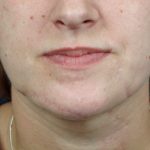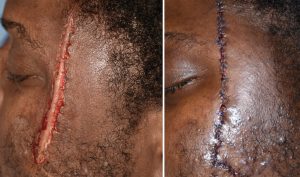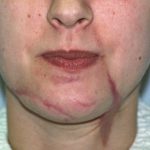
In some scars that appear to be healing poorly (wide, irregular, misaligned skin edges), scar revision before six months may be done. It is the progress of a scar over time that determines whether early or delayed scar revision may be beneficial.
Today’s plastic surgery techniques also allow for scar manipulation to be done as it progressively heals. It is wise, therefore, to see a plastic surgeon and have your scar followed as it heals. Certain methods may help a scar heal better along the way. For example, if the scar thickens, it can be treated with injectable steroids to reduce any unwanted hardness or fullness. If the scar stays red for too long, it can be treated with pulsed light therapy to lessen the undesirable redness. If the scar becomes darker due to sun exposure or your natural darker skin color, topical bleaching products may help the darker color fade.
2. Does Cocoa Butter or Vitamin E really work to improve scars?
There is no doubt that these two topical creams or oils have a historic belief that they are helpful for scar reduction. I have seen many patients over the years in my Indianapolis plastic surgery practice that have recounted stories of their relatives or even themselves that have seen the benefits of using them on scars and stretch marks. Despite these long-held beliefs, scientific studies have shown that they are largely urban myths. While good scientific studies in scar revision are largely lacking, a few scientific studies that have been done have shown that these treatments provide no improvement at all in an incision or scar. In fact, Vitamin E oil has been shown that it may actually slow wound healing. (this doesn’t mean that it makes scars worse, just that it does not make them better) Therefore, the use of these topical creams is mainly psychotherapeutic, not clinically effective.
3. What causes scarring and why is it noticeable? A scar is the result of the natural process of wound healing. The body does not always heal a wound with exactly the tissue that was cut or lost. Rather it mends and replaces injured tissue with on-specific collagen tissue to bind it back together. Whether the amount of scar tissue that is formed is a little or a lot depends on a lot of factors, such as the size of wound, how close the skin edges where as it heals, and the mechanism of injury. (e.g., incision, burn etc.) How much and what type of scar tissue that forms will have a significant impact on how much the scar is seen. There are other factors, beyond how the wound has healed, that also influences how a scar looks. A scar can be noticeable because it is a straight line that your eye can easily follow. Another reason a scar is visible is that the scar is darker or lighter than the surrounding skin color. Dark color may fade over time. A white scar, however, will not change color and is a permanent visible contrast to your surrounding pigmented skin. A scar may be visible because it is at a different level to that of the surrounding, It may be raised or indented, causing a visible contour deformity. Lastly, a scar may be adhered (scarred to) a nearby structure which causes it to move abnormally or be tethered as it tries to move. This causes visible distortion of both the scar and the normal structure during movement.
4. How can scar revision surgery make it look better?
Scar revision is a surgical approach to scar improvement. Fundamentally, it is about cutting out the scar and putting it back together. How it is put back together is different based on the type of scar and its location on the body.
Straight Line Repair. For some scars, it is as simple as cutting it out and putting it back together in the line or orientation that it lays. This can be very effective for scars that already lie along the relaxed skin tension lines of their locations. Some scars are simply too wide or depressed and need to be made thinner and more even with the surrounding skin. This is often how scars on the body (below the neck) are done.

Z-plasty Repair A z-plasty involves changing the scar from a straight line into a z-pattern. This accomplishes several scar benefits. It redirects the forces of tension and also lengthens a contracted or shortened scar. By’ irregularizing’ a straight line, it also serves to make it more difficult to see the scar and thereby camouflage it.
W-plasty Repair. The w-plasty serves to ‘irregularize’ a straight line and create a ‘pinking shear’ effect. It breaks up the entire straight line of a scar.
5. Is there any way to make scars look better without cutting them out? For scars that have some minor contour deformities ‘sanding’ is one approach. This can be done using mechanical dermabrasion or laser resurfacing. For scars that have some minor amounts of depression or indentation, injectable fillers can be used to raise the scar. Unfortunately, no currently available filler is permanent.
6. What is the difference between a keloid and a hypertrophic scar?
These two types of scars are commonly confused. I have seen lots of scar patients who thought they had a keloid when they did not. A keloid is a scar that grows beyond the boundaries of the original margins of the scar. A hypertrophic scar, on the other hand, is a very thick or widened scar but it stays within the edges of the scar. As a general rule, keloids rarely form on the face. The face is defined as the area in front of the ears and not involving the scalp and the neck. The areas where keloids are often distributed include the earlobes after ear piercing, the neck after shaving, and the back of the head after hair trimming and most often are found in African-Americans or darker complexion races. Keloids manifest and may continue to grow after a very minor insult like an ingrown hair or after shaving. Hypertrophic scars usually arise from a real injury of some kind and tend not to continue to grow. This distinction is very important as the treatment for these two scar types can be quite different. Keloids are well known to be difficult to treat and often require multiple treatments and surgeries for improvement.
Dr. Barry Eppley
Indianapolis, Indiana



